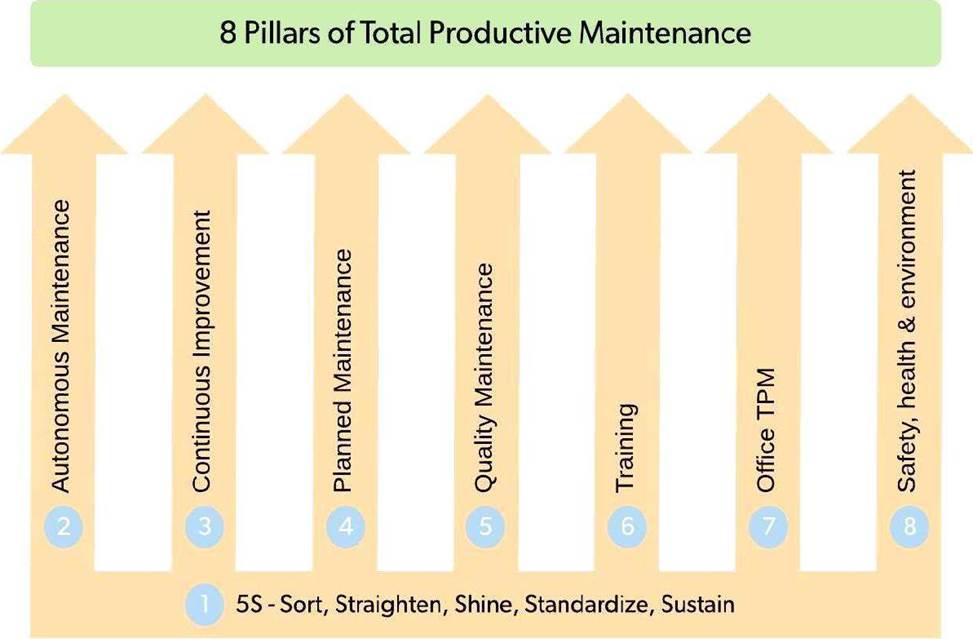Autonomous maintenance
Autonomous maintenance
A . 1 and 3 only
B . 2 and 4 only
C . 1 and 2 only
D . 2 and 3 only
Answer: B
Explanation:
Total productive maintenance (TPM) is an innovative concept in the manufacturing industry that evolved from the idea of preventive maintenance to adopt practices of productive maintenance, maintenance prevention, and reliability Engineering.
What we now refer to as TPM, has become an ingenious approach to achieve overall equipment effectiveness by involving the workforce behind the machines (i.e. the operators).
8 pillars of TPM

1) 5S – Sort, straighten, shine, standardize, and sustain
Just like a physical structure starts with a grounded framework, building a strong TPM process requires a strong foundation in the form of the principles of 5S. This is a workplace organization method that is simplified into 5 basic steps:
Sort tools, equipment, and materials to identify which of these can be discarded
Straighten and set things in proper order to reduce unnecessary motion and efficiently travel be-tween working groups and locations
Shine refers to performing necessary housekeeping to clean up the work area
Standardize and schedule activities to systematically form the habits to keep the workplace orga-nized
Sustain the process and principles for long-term applications
The 5S approach provides a systematic approach to cleaning the workplace, thereby uncovering underlying problems and challenges.
2) Autonomous maintenance
Maintenance tasks and caring for equipment should start with the people using the equipment. The empowerment of operators to work on small maintenance tasks effectively allows the maintenance teams to focus on more specialized assignments.
3) Continuous improvement
Also known as the Japanese term Kaizen, Continuous Improvement promotes the attitude of pro-gressing towards zero losses and zero defects. Through small but continual tweaks to processes, the overall effectiveness and efficiency of the organization is developed.
4) Planned maintenance
Planned maintenance activities are essential to the prevention of equipment breakdown. Planned maintenance is performed by periodically evaluating the condition of equipment to proactively prevent deterioration and mechanical failures.
5) Quality maintenance
To ensure the satisfaction of the customer, manufacturing processes aim for zero-defect production. Standards for superior quality, and checks on whether the standards are being met, should be in place. The goal of quality maintenance is to identify any possible causes of deviations from zero-defect production.
6) Training
The idea of TPM is that everyone does their part to contribute to the overall productivity of the production process. In order to achieve optimum performance, and to build each member’s competence, proper training is required to equip each one with the theoretical and practical know-how of working with machines and equipment.
7) Office TPM
A key role that is often overlooked is the administrative department that works behind the scenes. Like the rest of the production teams and processes, the management and administrative functions are also subject to productivity improvement. Tins includes identifying and eliminating losses, and contributing to the overall performance of the plant.
8) Safety, health, and environment
The last of the eight pillars focuses on creating a safe workplace. The essence of this pillar is real-ized
when actively applied to each of the other pillars. The successful implementation of this pillar will
contribute to a secure and hazard-free workplace.
Reference:
Total Productive Maintenance (TPM) – Upkeep
CIPS study guide page 163
LO 3, AC 3.1
Latest L4M7 Dumps Valid Version with 137 Q&As
Latest And Valid Q&A | Instant Download | Once Fail, Full Refund

